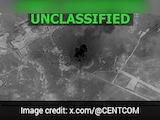Russia's President Vladimir Putin (back) and other high-ranked officials observe a minute of silence for victims of the Malaysia Airlines Boeing 777 plane crash before a meeting on economic issues at the Novo-Ogaryovo state residence outside Moscow on Jul
Reuters
Washington:
The first vivid demonstration of the war in Ukraine's sudden escalation came Monday, three days before the downing of a Malaysian civilian airliner.
A Ukrainian AN-26 transport plane was shot down by a surface-to-air missile while flying at 21,000 feet, an attack that US and Western officials believe was carried out either by Ukrainian separatists allied with Moscow or possibly even a Russian military unit.
More than half a dozen aircraft had been shot down in Ukraine in recent months, but this attack was different. Before Monday, only aircraft flying at relatively low altitudes - within the range of shoulder-fired weapons - were thought to be vulnerable to ground fire.
For the first time, a surface-to-air missile with greater range had been used, raising questions about whether the rebels have acquired such a devastating capability, and Russia's role.
As with the Malaysian jet, some rebels claimed credit for Monday's attack. But Western officials with access to classified information said that was just one possibility. Another was that the aircraft was downed by the Russian military, launching an SA-11 missile from the Russian side of the border to support the separatists.
One American official, who declined to be identified because he was discussing classified intelligence, said that the Russian military has two surface-to-air missile batteries positioned close to the border but that there was no conclusive evidence that those batteries fired the shot that brought down the Ukrainian plane on Monday.
This week's attacks came after a string of earlier incidents, including the June downing of a Ukrainian plane used to monitor the "Open Skies" treaty and several Ukrainian government helicopters.
Those attacks were attributed to Ukrainian separatists, who are believed to have amassed an arsenal of shoulder-fired anti-aircraft systems in an effort to neutralize the Ukrainian government's advantage in the air.
On Thursday, officials in Kiev also said that a Ukrainian SU-25 attack jet was shot down during a dogfight with a Russian plane. US officials said they did not have enough information to say why the plane crashed.
Despite the chaos in the skies over Ukraine, passenger aircraft continued to operate in the region. Only the airspace above Crimea and its surrounding waters was closed to aircraft. The Malaysian plane was flying on an approved route - the assumption by international aviation organizations was that civilian jetliners could fly far above the danger. It was flying at 33,000 feet on a busy route known as Airway L980, used by commercial carriers between Asia and northern Europe.
Edward Hunt, a defense consultant at IHS Jane's, said this was not unusual. "Lots of air corridors around the globe go over unstable areas," he said.
Kyla Evans, a spokeswoman for Eurocontrol, the Brussels-based agency that coordinates regional air-traffic management, said that the Ukrainian government had closed the route to any civilian air traffic flying below 32,000 feet.
In spite of the lower-elevation prohibition, Airway L980 had been busy with traffic each day flying the allowed higher elevations, the aviation official said. Prominent passenger carriers, including Malaysian Airlines and Air India, had continued to use it. But there had been worrying signs, and many carriers had begun to plan flights that skirted the conflict area.
Mikael Robertsson, a co-founder of FlightRadar24, a live flight-tracker service, said that some 300 to 400 commercial aircraft flew the airways over eastern Ukraine each day before the war, but that in recent months the traffic had fallen by at least half.
"Some airlines chose to use other routes," he said.
But even after Monday's downing of one of its transport planes, the Ukrainian government did not issue a Notice to Airmen, or Notam, closing the airspace, and both Eurocontrol and airlines continued to approve flight plans over eastern Ukraine.
Robertsson called it "a stupid decision to keep it open."
Russia, meanwhile, had taken steps to warn civilian aircraft not to fly over Russian territory near eastern Ukraine, where some of its own military forces are deployed.
A Russian notice issued Wednesday declared that the airway closures were necessary "due to combat actions on the territory of the Ukraine near the state border with the Russian Federation."
The closures were effective at midnight Wednesday - just hours before Malaysia Airlines Flight 17 took off. Because they were over Russian territory, these closures did not cover the area in Ukraine where Flight 17 crashed. But the plane was flying toward the closed areas, and it was not clear why the airline or Eurocontrol would have approved its flight plan in the face of such warnings.
Kenneth P. Quinn, the general counsel of the Flight Safety Foundation, said that even if there were a notice to airmen that any of the airspace was closed, a shoot-down "would still represent a flagrant violation of international law and an irresponsible attack on international civil aviation, because there are protocols in place to provide warning and precautions prior to shoot-down, whether surface-to-air or air-to-air."
Evans, at Eurocontrol, said that since the crash, the airspace in eastern Ukraine, known as the Dnepropetrovsk Flight Information Region, has been closed until further notice.
Now, Eurocontrol is rejecting all flight plans proposing to cross the region.
Hunt noted that many of the rebel anti-aircraft systems have had limited ranges, and the Ukrainian and Russian troops that possess longer-range air-defense systems have protocols for using them that reduce the likelihood of firing at clearly civilian targets.
He said there is a distinct difference between the Ukrainian military transport plane that was struck on Monday and the Malaysia Airlines Boeing aircraft. Because of that, he said it would be difficult for a trained air-defense crew to mistake one type of aircraft for the other.
A Ukrainian AN-26 transport plane was shot down by a surface-to-air missile while flying at 21,000 feet, an attack that US and Western officials believe was carried out either by Ukrainian separatists allied with Moscow or possibly even a Russian military unit.
More than half a dozen aircraft had been shot down in Ukraine in recent months, but this attack was different. Before Monday, only aircraft flying at relatively low altitudes - within the range of shoulder-fired weapons - were thought to be vulnerable to ground fire.
For the first time, a surface-to-air missile with greater range had been used, raising questions about whether the rebels have acquired such a devastating capability, and Russia's role.
As with the Malaysian jet, some rebels claimed credit for Monday's attack. But Western officials with access to classified information said that was just one possibility. Another was that the aircraft was downed by the Russian military, launching an SA-11 missile from the Russian side of the border to support the separatists.
One American official, who declined to be identified because he was discussing classified intelligence, said that the Russian military has two surface-to-air missile batteries positioned close to the border but that there was no conclusive evidence that those batteries fired the shot that brought down the Ukrainian plane on Monday.
This week's attacks came after a string of earlier incidents, including the June downing of a Ukrainian plane used to monitor the "Open Skies" treaty and several Ukrainian government helicopters.
Those attacks were attributed to Ukrainian separatists, who are believed to have amassed an arsenal of shoulder-fired anti-aircraft systems in an effort to neutralize the Ukrainian government's advantage in the air.
On Thursday, officials in Kiev also said that a Ukrainian SU-25 attack jet was shot down during a dogfight with a Russian plane. US officials said they did not have enough information to say why the plane crashed.
Despite the chaos in the skies over Ukraine, passenger aircraft continued to operate in the region. Only the airspace above Crimea and its surrounding waters was closed to aircraft. The Malaysian plane was flying on an approved route - the assumption by international aviation organizations was that civilian jetliners could fly far above the danger. It was flying at 33,000 feet on a busy route known as Airway L980, used by commercial carriers between Asia and northern Europe.
Edward Hunt, a defense consultant at IHS Jane's, said this was not unusual. "Lots of air corridors around the globe go over unstable areas," he said.
Kyla Evans, a spokeswoman for Eurocontrol, the Brussels-based agency that coordinates regional air-traffic management, said that the Ukrainian government had closed the route to any civilian air traffic flying below 32,000 feet.
In spite of the lower-elevation prohibition, Airway L980 had been busy with traffic each day flying the allowed higher elevations, the aviation official said. Prominent passenger carriers, including Malaysian Airlines and Air India, had continued to use it. But there had been worrying signs, and many carriers had begun to plan flights that skirted the conflict area.
Mikael Robertsson, a co-founder of FlightRadar24, a live flight-tracker service, said that some 300 to 400 commercial aircraft flew the airways over eastern Ukraine each day before the war, but that in recent months the traffic had fallen by at least half.
"Some airlines chose to use other routes," he said.
But even after Monday's downing of one of its transport planes, the Ukrainian government did not issue a Notice to Airmen, or Notam, closing the airspace, and both Eurocontrol and airlines continued to approve flight plans over eastern Ukraine.
Robertsson called it "a stupid decision to keep it open."
Russia, meanwhile, had taken steps to warn civilian aircraft not to fly over Russian territory near eastern Ukraine, where some of its own military forces are deployed.
A Russian notice issued Wednesday declared that the airway closures were necessary "due to combat actions on the territory of the Ukraine near the state border with the Russian Federation."
The closures were effective at midnight Wednesday - just hours before Malaysia Airlines Flight 17 took off. Because they were over Russian territory, these closures did not cover the area in Ukraine where Flight 17 crashed. But the plane was flying toward the closed areas, and it was not clear why the airline or Eurocontrol would have approved its flight plan in the face of such warnings.
Kenneth P. Quinn, the general counsel of the Flight Safety Foundation, said that even if there were a notice to airmen that any of the airspace was closed, a shoot-down "would still represent a flagrant violation of international law and an irresponsible attack on international civil aviation, because there are protocols in place to provide warning and precautions prior to shoot-down, whether surface-to-air or air-to-air."
Evans, at Eurocontrol, said that since the crash, the airspace in eastern Ukraine, known as the Dnepropetrovsk Flight Information Region, has been closed until further notice.
Now, Eurocontrol is rejecting all flight plans proposing to cross the region.
Hunt noted that many of the rebel anti-aircraft systems have had limited ranges, and the Ukrainian and Russian troops that possess longer-range air-defense systems have protocols for using them that reduce the likelihood of firing at clearly civilian targets.
He said there is a distinct difference between the Ukrainian military transport plane that was struck on Monday and the Malaysia Airlines Boeing aircraft. Because of that, he said it would be difficult for a trained air-defense crew to mistake one type of aircraft for the other.
© 2014, The New York Times News Service















